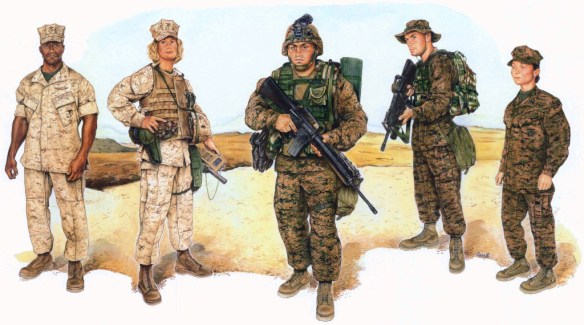A 2003 drawing showcasing the Marine Corps Combat Utility Uniform in desert and woodland-camouflaged variants.
Marine Infantry and artillery at Fallujah 2004
U.S. Central Command (CENTCOM) commander and U. S. Army general Tommy Franks controlled all coalition forces in the invasion of Iraq. Overall command of the Combined Forces Land Component Command (U. S. Army, U. S. Marine Corps, and coalition forces) in the March 2003 invasion was vested in U. S. Army lieutenant general David McKiernan, who simultaneously commanded U. S. Third Army/U. S. Army Forces Central Command. The U. S. Army contributed the V Corps of Third Army, of which the largest single unit was the 3rd Infantry Division. As the 3rd Infantry Division drove north from Kuwait toward Baghdad west of the Euphrates River, its marine corps equivalent, the I Marine Expeditionary Force (MEF), paralleled it to the east through the Iraqi heartland. The mission of the I MEF was to cross the Tigris and support the 3rd Infantry Division by threatening Baghdad from the east.
U.S. Marine Corps structure for the Iraq War resembled that of the 1991 Persian Gulf War. The I MEF of some 60,000 men was led by Lieutenant General James Conway. It was centered on the 1st Marine Division, a veteran unit of the 1991 Gulf War now commanded by Major General James Mattis that included three infantry regiments and one artillery regiment (each similar in size to an army brigade). Each infantry regiment had three infantry battalions. The 1st Marine Division also had two battalions of Abrams tanks. In addition to the 1st Marine Division, Conway controlled the II Marine Expeditionary Force, known as Task Force Tarawa (TFT), under Brigadier General Richard Natonski. It consisted of an infantry regiment and two marine expeditionary units (MEUs). Conway also had the 3rd Marine Aircraft Wing, commanded by Major General James Amos, and the British 1st Armoured Division. In all, the U. S. Marine Corps ground-force element numbered 4 infantry regiments, 2 artillery regiments, 3 reconnaissance battalions, 2 tank battalions, a service support group, and the 3 marine aircraft groups numbering about 400 aircraft.
The marines lacked the punch of the 3rd Infantry Division. Heavy marine air support somewhat offset this in the form of Sea Knight helicopters, Sea Cobra helicopters, Super Stallion helicopters, AV-8B Harrier IIs, and F/A-18 Hornet aircraft, but the marines also would have to face the major units of the Iraqi Army, while the 3rd Infantry Division was able to skirt most of these to the west and thus advance more rapidly on Baghdad.
Waves of deserters fled following air strikes or upon learning of the approach of the coalition ground force. The first major Iraqi resistance occurred in Nasiriyah, a junction over the strategic Euphrates River, where TFT was engaged during March 23-29. TFT’s success in clearing and holding open what became known as “Ambush Alley” allowed the I MEF to push north. The weather turned poor with the arrival of a shamal, or northerly wind, that brought on a heavy sandstorm. The 3rd Infantry Division now stalled on the west side of the Euphrates on March 26. While the I MEF could continue, thanks to air-based refueling and paved roads, it was intended to support the 3rd Infantry, not vice versa, so both divisions waited until March 30 to continue the advance.
On April 5 the 3rd Infantry Division reached Baghdad, and on March 7 and 8 the marines attacked the capital from the southeast. In the advance, cooperation was excellent between marine air and ground forces. The iconic tearing down of Saddam Hussein’s statute in Firdaws Square was accomplished by marines on April 9. Major combat operations were declared at an end on May 1.
The real war for coalition forces had only just begun. All three MEFs, plus the 4th Marine Division (reserves), would begin regular rotations in Iraq in the spring of 2004, beginning in Iraq’s largest province, Anbar, west of Baghdad. Subsequently, the marines have served throughout Iraq, with the First Battle and Second Battle of Fallujah as their most prominent actions. The marines engaged in counterinsurgency warfare for the first time since Vietnam.
U.S. Marine Corps and marine reservist fatalities, as of January 3, 2009, totaled 1,008 (including such categories as accident, homicide, and self-inflicted). In comparison, the U. S. Army, Army Reserves, and National Guard collectively suffered 3,059 fatalities, while the U. S. Navy and Naval Reserves saw fewer than 100 deaths, making active marines the second hardest hit in terms of fatalities (marine reservists totaled fewer than 150 fatalities). Marines wounded in action by early January 2009 totaled 8,550, with many more thousands wounded due to nonhostile actions and medical issues.
References Keegan, John. The Iraq War: The Military Offensive, from Victory in 21 Days to the Insurgent Aftermath. New York: Vintage, 2005. Livingston, Gary. An Nasiriyah: The Fight for the Bridges. North Topsail Island, NC: Caisson, 2004. Lowry, Richard, with Howard Gerrard. US Marines in Iraq: Operation Iraqi Freedom, 2003. Oxford, UK: Osprey, 2006. Murray, Williamson, and Robert H. Scales Jr. The Iraq War: A Military History. Cambridge, MA: Belknap, 2005. Pritchard, Tim. Ambush Alley: The Most Extraordinary Battle of the Iraq War. New York: Ballatine Books, 2007. Reynolds, Nicholas E. Basrah, Baghdad, and Beyond: The U. S. Marine Corps in the Second Iraq War. Annapolis, MD: Naval Institute Press, 2005. Strebe, Amy. Desert Dogs: The Marines of Operation Iraqi Freedom. New York: MBI Publishing, 2004. West, Bing, and Ray L. Smith. The March Up: Taking Baghdad with the 1st Marine Division. New York: Bantam, 2003.
